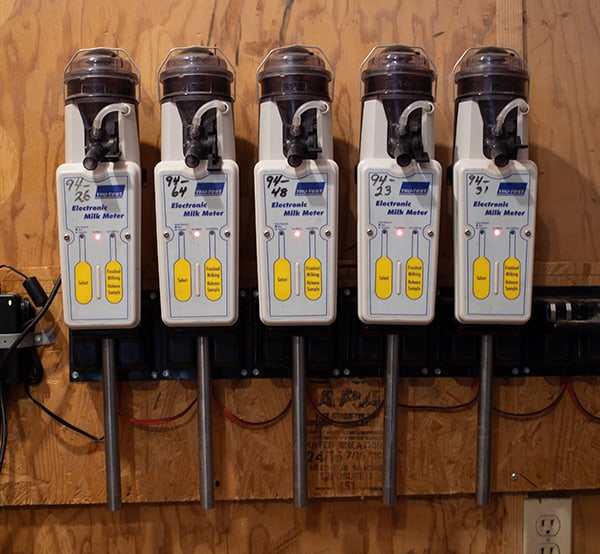Keeping Pace To Best Serve Our Members
Milk testing looks a little different today than it did 20 years ago, and for good reason. As the dairy industry evolves and farmers adopt new technologies like robots, rotaries and RFID tag-driven systems, VAS has been keeping pace to best serve you, our members. Rodney Davis, Director of VAS Field Operations, shares his perspective on how implementing new technology has improved milk testing services for VAS members.
Efficiencies result in data assurance
Producers might notice it takes significantly less time to receive their results than it used to – typically within 24 hours – thanks to investments in technology to boost efficiencies.
“Field technicians perform data entry in the field using VAS software rather than by hand in the office like we used to,” says Davis. This means that data is instantly sent via the iLoop, a network connection with the DRPC in Madison, where it will be incorporated into test day results. “What used to take three to four days to make it from farm to lab and back to farm again, now might take less than 24 hours. It’s a huge advantage for producers when making management decisions,” notes Davis on delivering information back to members.
And as herd size increases, so does the importance of sample collection efficiency. “We have to make sure that the dairy can remain efficient as possible, even on a test day,” says Davis. The VAS team uses data handlers which allow a technician to enter cow IDs and milk weights on a small handheld device, RFID wands that aid in recording animal IDs and electronic milk meters (EMMs) which allow for faster sampling and less waste.

“When we use these tools we minimize the amount of time it takes to sample. A farm with 1,000 cows might take the same amount of time as a dairy with 100 cows when we utilize all the tools available to us,” says Davis. However, things move fast in a rotary and the testing team needs to keep up, “we don’t have much of a choice – we have to match the pace of these parlor systems and that means using cutting-edge technology.”
Not only does technology increase efficiency on your test day, it adds an extra level of assurance when it comes to data accuracy. “We’ve started using RFID chips in the milk sample bottles. We can scan them in the parlor and then they’re scanned again in the lab. This adds an extra layer of assurance when producers think of connecting a cow and her sample,” says Davis. While VAS has always taken data integrity and accuracy very seriously, incorporating technology adds extra peace of mind and confidence when making management decisions.
Improving test day efficiencies is only one component when it comes to keeping pace with the bigger dairy tech trajectory. The data generated, collected and analyzed on your farm is also subject to innovation. A single milk sample goes beyond fat, protein and somatic cell. Now a test day milk sample can be used to diagnose pregnancy, screen for disease, detect subclinical ketosis and give feedback on rumen health through fatty acids, too.
Managing and leveraging test day information is important for dairies of all sizes – which is why VAS is excited to roll out a new DairyComp product geared towards smaller dairies later this year. DairyComp Pro, DairyComp’s cloud-based sister, collects and record the most important herd information on a farm.
And soon, all members will be able to view their test-day information on VAS’ cloud-based data delivery platform, VAS PULSE.
There is nothing old school about the valuable data collected from milk testing. As the dairy industry evolves and changes, VAS is laying the groundwork for that data to play a role into the future.
Adapting to changing parlor systems
Producers help drive the development of new testing technology and procedures, and the adoption of robotic milkers are no exception. VAS has expanded services to include sampling on robotic milkers as they become increasingly more popular among VAS members.
“When we sample a farm with robots we drop off a sampler, or shuttle, to connect to the robotic milker where it will stay on the machine for 12-24 hours. During that time the robot keeps track of which cows have been sampled,” says Davis. Some producers, like Peter Winch of Fennimore, Wis. are comfortable setting it up themselves. Check out the video of Peter hooking up a sampler to his robotic milker .
VAS field technicians also come on farm to set up samplers. The team utilizes TeamViewer software allowing them to remotely check in to make sure things are running smoothly during the testing period.
Insights for the future
Improving test day efficiencies is only one component when it comes to keeping pace with the bigger dairy tech trajectory. The data generated, collected and analyzed on your farm is also subject to innovation. A single milk sample goes beyond fat, protein and somatic cell. Now a test day milk sample can be used to diagnose pregnancy, screen for disease, detect subclinical ketosis and give feedback on rumen health through fatty acids, too.
Managing and leveraging test day information is important for dairies of all sizes – which is why VAS is excited to roll out a new DairyComp product geared towards smaller dairies later this year. DairyComp Pro, DairyComp’s cloud-based sister, collects and record the most important herd information on a farm.
And soon, all members will be able to view their test-day information on VAS’ cloud-based data delivery platform, VAS PULSE.
There is nothing old school about the valuable data collected from milk testing. As the dairy industry evolves and changes, VAS is laying the groundwork for that data to play a role into the future.

